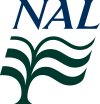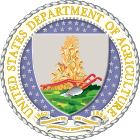- United States National Agricultural Library
-
"National Agricultural Library" redirects here. For other uses, see National Agricultural Library (disambiguation).
U.S. National Agricultural Library 
Type National library Established 1862 Reference to legal mandate Organic Act (May 15, 1862)[1] Location Beltsville, Maryland Coordinates 39°1′23″N 76°55′17.5″W / 39.02306°N 76.921528°WCoordinates: 39°1′23″N 76°55′17.5″W / 39.02306°N 76.921528°W Branches 1 (Washington D.C.) Collection Size approx. 4,000,000[2] Other information Budget approx. $22,000,000 (FY 2007)[2] Director Dr. Simon Y. Liu [3] Staff 215[2] Website http://www.nal.usda.gov The United States National Agricultural Library (NAL) is one of the world's largest agricultural research libraries, and serves as a National Library of the United States and as the library of the United States Department of Agriculture. Located in Beltsville, Maryland, it is one of four national libraries of the United States (along with the Library of Congress, the National Library of Medicine, and the National Library of Education). It is also the coordinator for the Agriculture Network Information Center, a national network of state land-grant institutions and coordinator for the U.S. Department of Agriculture (USDA) field libraries.
NAL was established on May 15, 1862 by the signing of the Organic Act by Abraham Lincoln. It served as a departmental library until 1962, when the Secretary of Agriculture officially designated it as the National Agricultural Library. The first librarian, appointed in 1867, was Aaron B. Grosh, one of the founders of the National Grange of the Order of Patrons of Husbandry.
Contents
History
NAL was established as the U.S. Department of Agriculture Library on May 15, 1862 by the signing of the Organic Act by Abraham Lincoln. In 1863, the library's collection comprised 1,000 volumes that had been transferred from the U.S. Patent Office's Agricultural Division. By 1889, the library's collection had increased to 20,000 volumes, and a librarian from Amherst College was hired to create a classification system for the library's collection. At this time, the library was located on the second floor of the Department of Agriculture's main building. In 1893, William Cutter was hired as Librarian of the Department, and he began a reorganization effort to modernize the library and improve its effectiveness. His primary achievement was consolidating the library's collection of 38,000 volumes into one central library; previously, more than half of the library's collection was held in divisional libraries across the United States. By 1900, the library's collection contained 68,000 volumes, and in 1915, the library was moved to a larger facility in the Bieber Office Building at 1358 B Street SW, Washington DC. The library moved again in 1932 to facilities in the USDA's South Building on Independence Avenue.[1]
In 1934, the collection reached 250,000 volumes in size, and the library began participating in the Bibliofilm Service, which, along with the American Documentation Institute and the Science Service, supplied microfilm copies of articles to scientists. This was the first large-scale attempt by a library to provide copies of library materials to patrons rather than the original documents, and during its first year, over 300,000 copies were distributed.[1]
During World War II, the Department of Agriculture underwent reorganization to address wartime needs. The library, which had been decentralized since 1920, was consolidated into a central facility under the direction of Department Librarian Ralph R. Shaw.
On May 23, 1962, the 100th anniversary of the library's establishment, Secretary of Agriculture Orville Freeman officially designated the library as the National Agricultural Library, making it the third national library in the United States. In 1964, funds were appropriated by Congress to begin planning for a new library facility in Beltsville, Maryland on the grounds of the Beltsville Agricultural Research Center. Construction on the new facility began in 1965, and it first opened in 1969. In 2000, Secretary of Agriculture Dan Glickman designated the building as the Abraham Lincoln Building.[4]
Librarians of the Department of Agriculture
- Aaron B. Grosh (1867–1869)[1]
- Stuart Eldridge (1869–1871)[5]
- John B. Russell (1871–1877)[5]
- Ernestine H. Stevens (1877–1893)[5]
- William P. Cutter (1893–1901)[1]
- Josephine Clark (1901–1907)[1]
- Claribel Barnett (1907–1940)[1]
- Ralph R. Shaw (1940–1954)[1]
- Foster E. Mohrhardt (1954–1968)[1]
- John Sherrod (1968–1973)[1]
- Richard Farley (1973–1983)[1]
- Joseph Howard (1983–1994)[6]
- Pamela Q.J. Andre (1994–2002)[7]
- Peter Young (2002–2008)[8]
- Simon Y. Liu (2010–)[9]
Facilities
The main library is housed in the Abraham Lincoln Building, a seventeen-story facility on the grounds of the Henry A. Wallace Beltsville Agricultural Research Center in Beltsville, Maryland. NAL also operates a Washington D.C. branch known as the DC Reference Center, which is located in the USDA's South Building.[10]
Services
AGRICOLA
NAL maintains AGRICOLA (AGRICultural OnLine Access), the largest bibliographic database of agricultural literature in the world.[11] It contains more than 4.1 million records for publications dating as far back as the 15th century. 78 percent of the records are for journal articles and book chapters, while 22 percent cover full-length books, journals, maps, electronic resources, and audiovisual materials.[12] The database indexes publications from many disciplines related to agriculture, including veterinary sciences, entomology, forestry, aquaculture and fisheries, economics, food and human nutrition, and environmental sciences.
AGRICOLA originated in 1942 as the Bibliography of Agriculture, a printed index of article citation records. It was first digitized in 1970, when records were placed on magnetic tapes rather than reproducing them manually.[5] The name was changed to AGRICOLA at this time, and the records were made available through database vendors such as Dialog and OCLC. In 1998, it became available to the general public for free on the World Wide Web.[12]
National Agricultural Library Digital Repository
The NAL Digital Repository [1], created in April 2006, serves as a digital archive of historical USDA documents. The repository contains over 600,000 pages of digitized texts. Publications contained in the repository include the issues of the Journal of Agricultural Research from 1913–1949 and the archives of the Yearbook of the United States Department of Agriculture dating back to 1894.[13]
Information Centers
NAL also houses several specialized information centers, which provide access to comprehensive and essential information resources focusing on the specific aspects of agricultural subjects. In addition to the general reference services available at NAL, each center offers Internet access to resources enhancing information availability and dissemination. The centers have staff available to serve customers on-site as well as by phone, fax or email. The Information Centers at the National Agricultural Library include:
- Alternative Farming Systems Information Center
- Animal Welfare Information Center
- Food and Nutrition Information Center
- SNAP-Ed Connection
- Healthy School Meals Resource System
- International Bibliographic Information on Dietary Supplements Database (IBIDS)
- Nutrition.gov
- WIC Works Resource System
- Food Safety Information Center
- National Invasive Species Information Center
- Rural Information Center
- Water Quality Information Center
References
- ^ a b c d e f g h i j k Fusione, Alan E. 1988. The history of the National Agricultural Library. Agricultural History 62(2):189-207.
- ^ a b c Learn About NAL. June 2008. Retrieved on 2008-12-05.
- ^ Key NAL Personnel and Services. National Agricultural Library website. Retrieved on 2010-07-02.
- ^ . http://findarticles.com/p/articles/mi_hb5243/is_200006/ai_n20019579.[dead link]
- ^ a b c d Paskoff, Beth M. 1990. History and characteristics of agricultural libraries and information in the United States. Library Trends 38(3):331-349.
- ^ National Agricultural Library Annual Report for 1993. U.S. Department of Agriculture, Beltsville, Maryland. 1994. Retrieved on 2008-12-15.
- ^ National Agricultural Library 2000-2002. U.S. Department of Agriculture, Beltsville, Maryland. 2002. Retrieved on 2008-12-15.
- ^ Library of Congress Announces New Asian Division Chief. Library of Congress (press release). 2008-10-23. Retrieved on 2008-12-15.
- ^ Dr. Simon Y. Liu Named New NAL Director U.S. Department of Agriculture, Beltsville, Maryland. 2010. Retrieved on 2010-01-20.
- ^ DC Reference Center. National Agricultural Library website. Retrieved on 2008-12-22.
- ^ AGRICOLA a useful database on agriculture, veterinary science. Journal of the American Veterinary Medical Association. 2001-10-01. Retrieved on 2008-12-05.
- ^ a b Specifications for cataloging and indexing records from the National Agricultural Library. National Agricultural Library. July 2006. Retrieved on 2008-12-05.
- ^ About NALDR. National Agricultural Library. Retrieved on 2008-12-22.
External links
- "National Agricultural Library". http://www.nal.usda.gov/.
- "NAL Agricultural Thesaurus". http://agclass.nal.usda.gov/agt.shtml.
- "Additional AGRICOLA Database-related Resource(s)". http://www.ntis.gov/products/types/databases/agricola.asp.
 United States National Libraries
United States National Libraries Department of Agriculture: National Agricultural Library
Department of Agriculture: National Agricultural Library  Congress: Library of Congress
Congress: Library of Congress  Department of Transportation: National Transportation Library
Department of Transportation: National Transportation Library  Department of Health and Human Services / National Institutes of Health: National Library of Medicine
Department of Health and Human Services / National Institutes of Health: National Library of Medicine  Department of Education: National Library of EducationOther related libraries and services: Federal Depository Library Program · National Archives and Records Administration (NARA) · Presidential library systemCategories:
Department of Education: National Library of EducationOther related libraries and services: Federal Depository Library Program · National Archives and Records Administration (NARA) · Presidential library systemCategories:- National libraries
- Research libraries
- Agriculture in the United States
- United States Department of Agriculture
- Buildings and structures in Prince George's County, Maryland
Wikimedia Foundation. 2010.


